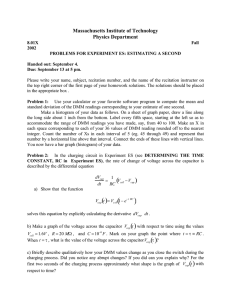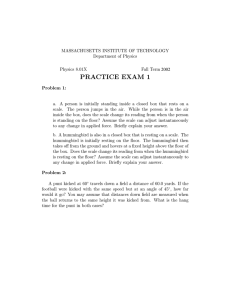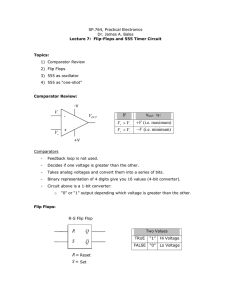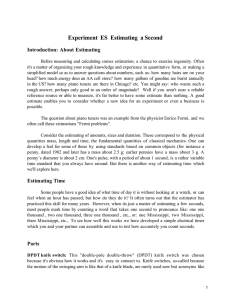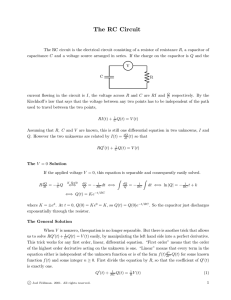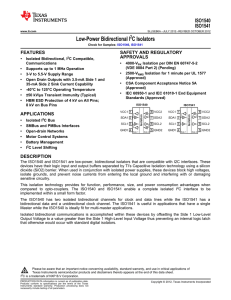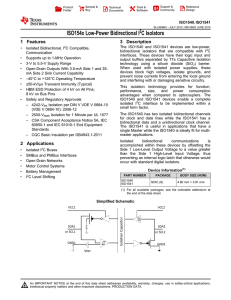Massachusetts Institute of Technology Physics Department
advertisement
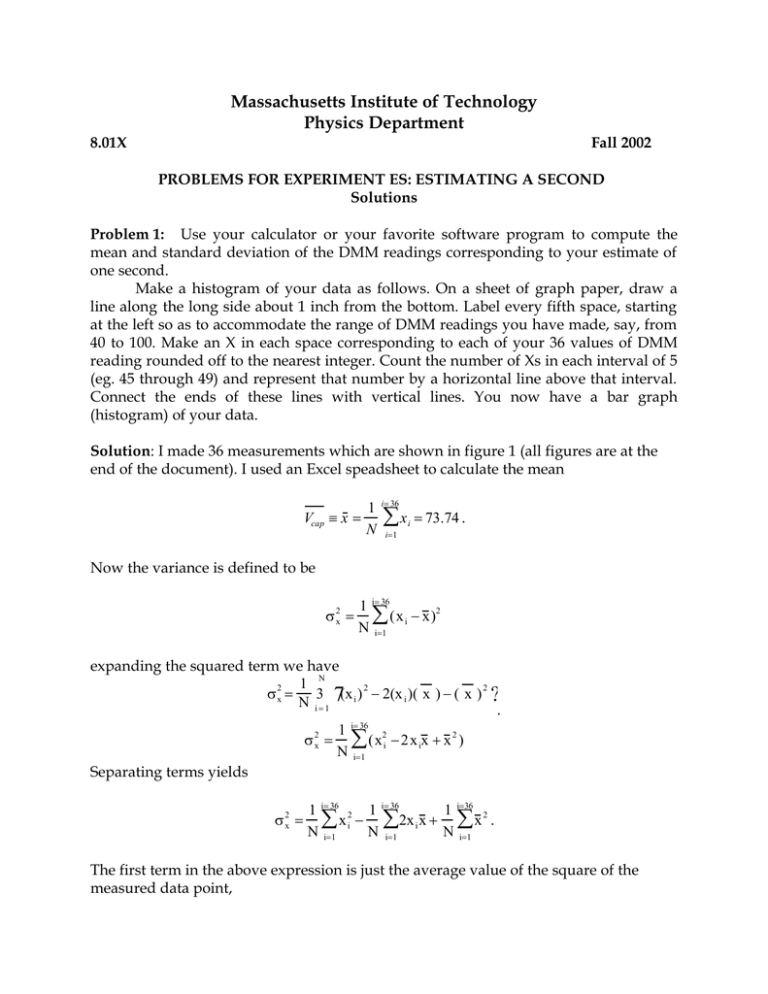
Massachusetts Institute of Technology Physics Department 8.01X Fall 2002 PROBLEMS FOR EXPERIMENT ES: ESTIMATING A SECOND Solutions Problem 1: Use your calculator or your favorite software program to compute the mean and standard deviation of the DMM readings corresponding to your estimate of one second. Make a histogram of your data as follows. On a sheet of graph paper, draw a line along the long side about 1 inch from the bottom. Label every fifth space, starting at the left so as to accommodate the range of DMM readings you have made, say, from 40 to 100. Make an X in each space corresponding to each of your 36 values of DMM reading rounded off to the nearest integer. Count the number of Xs in each interval of 5 (eg. 45 through 49) and represent that number by a horizontal line above that interval. Connect the ends of these lines with vertical lines. You now have a bar graph (histogram) of your data. Solution: I made 36 measurements which are shown in figure 1 (all figures are at the end of the document). I used an Excel speadsheet to calculate the mean Vcap 1 ≡x= N i= 36 ∑x i = 73.74 . i=1 Now the variance is defined to be σ 2x = 1 i= 36 (x i − x )2 ∑ N i=1 expanding the squared term we have N 1 2 2 2 σx = 3 (x ) − 2(x i )( x ) − ( x ) ? N i=1 7 i . σ 2x = 1 i= 36 2 ∑ (x − 2x ix + x 2 ) N i=1 i Separating terms yields σ 2x = 1 i= 36 2 1 i= 36 1 i=36 x i − ∑2x i x + ∑ x 2 . ∑ N i=1 N i=1 N i=1 The first term in the above expression is just the average value of the square of the measured data point, 1 i=36 2 x i = (x 2i ) . ∑ N i=1 The second term is 1 i= 36 −2x ∑ x i = −2x2 . N i=1 The third term, 1 i=36 2 ∑ x = x2 . N i=1 So the variance becomes σ x = (x i ) − x . 2 2 2 I used an Excel spreadsheet to calculate the mean of the square of the measured value and found 2 (x i ) = 5488.39 . Thus the square root of the variance is σ x = ( xi2 ) − x 2 = (5488.39) − (73.74)2 = 7.23 , The standard deviation is defined to be s= N 36 σx = 7.23 = 7.33 . N −1 35 I included a plot of the distribution of my data with lines indicating the mean and the standard deviation on both sides of the mean in figure 2. In figure 3, I show the histogram of the data with bin sizes equal to two. Problem 2: In the charging circuit in Experiment ES (see DETERMINING THE TIME CONSTANT, RC in Experiment ES), the rate of change of voltage across the capacitor is described by the differential equation dVcap = dt 1 (Vcell − Vcap ) RC a) Show that the function ( Vcap (t )= Vc ell 1− e − t RC ) solves this equation by explicitly calculating the derivative dVcap dt . b) Make a graph of the voltage across the capacitor Vcap (t ) with respect to time using the values Vcell = 1.6V , R = 20 MΩ , and C = 10−6 F . Mark on your graph the point where t = τ ≡ RC . When t = τ , what is the value of the voltage across the capacitor Vcap(τ )? c) Briefly describe qualitatively how your DMM values change as you close the switch during the charging process. Did you notice any abrupt changes? If you did can you explain why? For the first two seconds of the charging process approximately what shape is the graph of Vcap (t ) with respect to time? Solution: Part a) I begin by explicitly computing the derivative of the function ( Vcap (t )= Vc ell 1− e − t RC ) that appears on the left hand side of the differential equation dVcap dt = 1 (Vcell − Vcap ). RC We need two facts: 1) The derivative of a constant is zero and 2) the derivative of the exponential is ( d Vcelle −t dt RC )= − RC V 1 e −t ce ll RC . Thus the derivative that appears on the Left hand side (LHS) of the differential equation can be calculated and we find dVcap LHS = dt = ( d −t Vce ll (1− e dt ) ) = RC Vcell − t RC e . RC We substitute our result for Vcap (t ) into the right hand side (RHS) of the differential equation yielding RHS = ( ( 1 Vc ell − (Vcell 1− e −t RC RC ))= RC e Vcell −t R C Comparing the two sides we see agreement so we conclude that our function for the voltage across the capacitor does solve the differential equation. ( Part b) In figure 4, I plotted Vcap (t )= Vc ell 1− e − t RC ) by explicitly calculating the value for time increments of 0.5 s. The data for the graph is shown in figure 5. In particular the time constant is ( ) τ = RC = (20 MΩ) 10 F = 20 s −6 The value of the voltage across the capacitance at t = 20 s is ( Vcap (t = 20s)= Vce ll 1− e −1 )= 1.01. Part c) At 200 mV my digital multimeter generated a beeping sound, re-zeroed and then switched to readings in volts. I noticed that the charging process also slowed down considerably. This happens because above 200 mV the DMM switches to a new range which has a different resistance. The value of R is much greater hence the time constant increases which means that the capacitor takes longer to charge. This occurs at around 3 s, so for the behavior over the first two seconds my graph in part b is still a good description of the charging. That graph is nearly linear over the interval [0., 2 s]. Using our equation for the voltage across the capacitor, we can find the time that it takes for the capacitor to reach a given voltage. I start with the equation ( Vcap (t )= Vc ell 1− e − t RC ). Isolate the exponential term with a little algebra, to get e −t RC = 1− Vcap (t ) Vc ell . Take the natural logarithm of both sides of the above equation V (t ) cap . ln e −t R C = ln1− Vcell ( ) The left hand side is ( ) ln e −t R C = − So the equation becomes − Solve this for time t . RC V (t ) t cap . = ln 1− RC V ce ll V (t ) cap . t = −RC ln1− V cell From Problem One, the mean value for the voltage across the capacitor is Vcap = 73.74 . The time this occurs at is Substitute my values for the quantities and get V (t ) cap = −(20s )ln 1− .074V = .92s . t = −RC ln1− Vcell 1.6V I don’t expect my answer to be exactly 1 s mainly because the values of the resistor and capacitor are only accurate to about 5%. However my error is 8% while my ratio of s 7.23 = = 9.8% . Vcap 73.74
